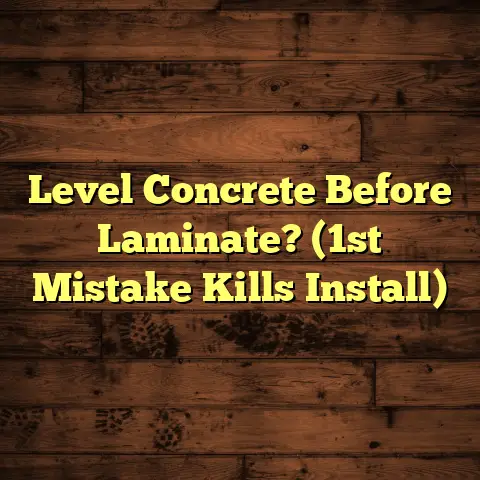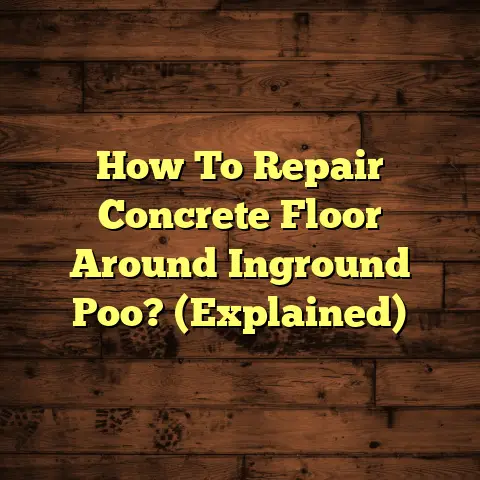Remove Tile Floor With Mesh (7 Subfloor Mistakes!)
Remember the story of the Tortoise and the Hare? That’s home renovation in a nutshell. Rushing through a tile removal project is a recipe for disaster.
Slow and steady wins the race, especially when it comes to protecting your subfloor. I’ve seen it all in my years as a flooring contractor, and trust me, patience pays off!
The Basics of Tile Removal
So, you’re staring at that outdated tile, ready for a change. The tile removal process, at its core, is pretty straightforward.
You’ll need a few key tools:
- Safety Glasses: Seriously, protect your eyes!
- Gloves: Your hands will thank you.
- Dust Mask/Respirator: Tile dust is nasty stuff.
- Hammer: For persuasion.
- Chisel/Scraper: To get under those stubborn tiles.
- Grout Removal Tool: More on this later.
- Shop Vacuum: Essential for cleanup.
- Trowel (For applying mortar to set the tiles)
- Mortar Mixing Kit (bucket, mixing drill, etc.)
Different tiles present different challenges. Ceramic is generally easier to remove than porcelain, which is denser and more durable.
Natural stone tiles, like slate or granite, can be tricky due to their varying thicknesses and textures. And then there’s the dreaded mesh.
Mesh, often fiberglass or a similar material, is sometimes embedded in the mortar bed beneath the tile. It’s used to add strength and stability, especially over larger areas or potentially unstable subfloors.
While it provides structural integrity, it can make tile removal a real headache! It creates a stronger bond, making it harder to separate the tile and mortar from the subfloor.
Understanding the Subfloor
Okay, let’s talk about what’s underneath the tile. The subfloor is the foundation upon which your entire flooring system rests.
It provides a smooth, level surface for the tile (or any other flooring) to be installed. Think of it as the unsung hero of your flooring project.
The most common types of subfloors are:
- Plywood: Typically used in wood-frame construction.
- OSB (Oriented Strand Board): A cheaper alternative to plywood.
- Concrete: Common in basements and slab-on-grade homes.
Each type reacts differently to tile removal. Plywood and OSB are more susceptible to damage from moisture and aggressive scraping. Concrete, while durable, can still crack or chip if you’re not careful.
Before you even think about swinging that hammer, you need to assess the condition of your subfloor. This is absolutely crucial!
Mistake #1 – Skipping the Assessment
Seriously, don’t skip this step. It’s like a doctor diagnosing an illness without an exam. You’re just guessing, and that’s never a good idea in home renovation.
Look for these telltale signs of trouble:
- Soft Spots: Press down firmly. Does it feel spongy? That’s a sign of rot or water damage.
- Discoloration: Stains or dark patches indicate moisture.
- Cracks: Especially in concrete subfloors.
- Loose Fasteners: Are the screws or nails holding the subfloor down secure?
- Unevenness: Use a level to check for dips or humps.
I once worked on a bathroom remodel where the homeowner assured me the subfloor was “fine.” Famous last words!
After removing the tile, we discovered extensive rot underneath, caused by a leaky toilet. The entire subfloor had to be replaced, adding thousands to the project cost.
Had they assessed the subfloor beforehand, they could have addressed the leak and avoided a major headache.
Mistake #2 – Ignoring Safety Precautions
Tile removal can be surprisingly dangerous. Flying debris, sharp tools, and dust can all cause serious injuries. Don’t be a hero – protect yourself!
Here’s your safety checklist:
- Safety Glasses: Protect your eyes from flying tile chips and grout dust.
- Gloves: Protect your hands from cuts and abrasions.
- Dust Mask/Respirator: Tile dust contains silica, which can cause lung damage over time.
- Knee Pads: Save your knees! You’ll be spending a lot of time on the floor.
- Closed-Toe Shoes: Protect your feet from dropped tools and sharp objects.
I remember a DIYer who decided to remove tile in sandals. A large tile chip landed right on his toe, resulting in a trip to the emergency room and a painful lesson learned.
Don’t let that be you! Safety first, always.
Mistake #3 – Using the Wrong Tools
Using the wrong tool for the job is like trying to cut a steak with a spoon. It’s frustrating, inefficient, and can even be dangerous.
Here are some essential tools for tile removal:
- Grout Saw/Scraper: For removing grout.
- Chisel: For lifting tiles.
- Hammer: For tapping the chisel.
- Floor Scraper: For removing thin-set mortar.
- Angle Grinder with Diamond Blade: For cutting tiles (use with extreme caution!).
- Shop Vacuum: For cleaning up dust and debris.
Manual tools are great for smaller jobs or tight spaces. Power tools, like a demolition hammer or an angle grinder, can speed things up on larger projects.
However, power tools require extra caution. It’s easy to damage the subfloor if you’re not careful.
I once saw a homeowner try to remove tile with a sledgehammer. The result? A completely destroyed subfloor and a very expensive repair bill.
Choose the right tool for the job, and use it with care.
Mistake #4 – Neglecting to Remove Grout Properly
Grout acts like glue, holding the tiles firmly in place. Trying to remove tiles without removing the grout first is like trying to separate two LEGO bricks that are stuck together. It’s going to be tough, and you’re likely to damage something.
There are several ways to remove grout:
- Grout Saw: A manual tool that’s good for small areas.
- Grout Scraper: A powered tool that’s faster and more efficient.
- Oscillating Multi-Tool with Grout Removal Blade: A versatile tool that can also be used for other tasks.
Whichever method you choose, be patient and thorough. Make sure to remove as much grout as possible before attempting to lift the tiles.
I’ve seen projects where people tried to skip this step, resulting in cracked tiles, damaged subfloors, and a whole lot of frustration.
Take the time to remove the grout properly, and you’ll save yourself a lot of headaches down the road.
Mistake #5 – Failing to Plan for Waste Disposal
Tile removal generates a lot of waste. Old tiles, mortar, grout – it all adds up quickly. Don’t wait until you’re knee-deep in debris to figure out what to do with it all.
Before you start, consider these factors:
- Volume of Waste: Estimate how much waste you’ll generate.
- Local Regulations: Check your local regulations regarding tile disposal.
- Disposal Options: Consider renting a dumpster, hiring a junk removal service, or hauling the waste to a landfill yourself.
Some areas have specific regulations regarding the disposal of construction debris. You may need to separate the tile from other materials, or you may be required to dispose of it at a designated facility.
I once worked on a project where the homeowner illegally dumped the tile waste in a vacant lot. They were fined heavily and had to pay for the cleanup.
Don’t make the same mistake. Plan ahead and dispose of your waste responsibly.
Mistake #6 – Not Accounting for Floor Height Adjustments
Removing tile flooring can significantly change the height of your floor. This can create problems with doorways, transitions to other rooms, and even furniture placement.
Think about it: the tile, the mortar bed, and any underlayment all contribute to the overall floor height. When you remove them, you’re essentially lowering the floor.
This can lead to issues like:
- Doors that Drag: The door may now be too long and rub against the floor.
- Uneven Transitions: A noticeable height difference between rooms can be a tripping hazard.
- Furniture Fit: Furniture that was previously flush with the floor may now wobble.
To address these issues, you may need to:
- Trim Doors: Shorten the doors to prevent them from dragging.
- Install Transitions: Use transition strips to create a smooth transition between rooms.
- Shim Furniture: Add shims under furniture legs to level them.
Failing to account for these height adjustments can result in a finished project that looks unprofessional and functions poorly.
Mistake #7 – Overlooking Post-Removal Subfloor Repair
Once the tile is gone, your work isn’t over. In fact, it’s just beginning! You need to carefully inspect the subfloor for any damage and make necessary repairs.
Common issues include:
- Cracks: Especially in concrete subfloors.
- Gaps: Between plywood or OSB sheets.
- Loose Fasteners: Screws or nails that have come loose.
- Moisture Damage: Rot or mold.
- Thin-Set Residue: Lingering mortar that needs to be scraped away.
Ignoring these issues can compromise the stability and longevity of your new flooring.
Cracks can worsen over time, leading to unevenness and potential tile failure. Moisture damage can spread, causing rot and mold.
Before installing your new flooring, make sure to:
- Fill Cracks: Use a concrete patch or wood filler.
- Fill Gaps: Use a wood filler or caulk.
- Tighten Loose Fasteners: Replace any missing or damaged screws or nails.
- Address Moisture Damage: Repair any leaks and treat affected areas with a mold killer.
- Scrape Away Thin-Set Residue: Use a floor scraper to remove any remaining mortar.
A properly prepared subfloor is essential for a successful flooring project. Don’t cut corners on this step!
The Road to a Successful Flooring Project
Removing tile flooring is a challenging but rewarding project. By avoiding these seven common mistakes, you can protect your subfloor, save yourself time and money, and achieve a beautiful, long-lasting result.
Remember the Tortoise and the Hare. Slow and steady wins the race. Take your time, be thorough, and don’t be afraid to ask for help when you need it.
And who knows, maybe you’ll even enjoy the process! Okay, maybe not enjoy, but at least you’ll avoid a major renovation disaster. Good luck, and happy flooring!





